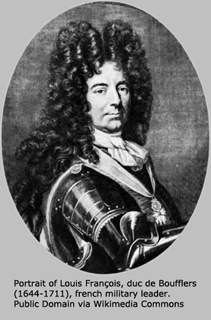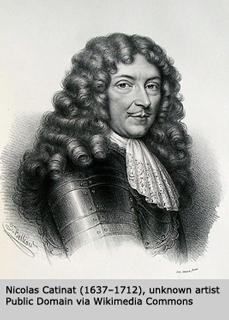 French artist/engraver, Pierre Giffart (1638–1723), illustrated a 1696 book by Marshal of France Louis François de Boufflers, Duke of Boufflers, Count of Cagny (1644–1711), L'art militaire françois pour l'infanterie. Contenant l'exercice & le maniement des Armes, tant des officiers que des Soldats, representé par des Figures en taille-douce déssinées d'aprés Nature. (French Military Art for Infantry. Containing arms and their handling, for both officers and soldiers, represented by printed figures drawn from actual observations.) The book contains a bayonet drill to draw, raise, and place the bayonet on the musket. To the best of my knowledge, these are the earliest known images of a socket bayonet.
French artist/engraver, Pierre Giffart (1638–1723), illustrated a 1696 book by Marshal of France Louis François de Boufflers, Duke of Boufflers, Count of Cagny (1644–1711), L'art militaire françois pour l'infanterie. Contenant l'exercice & le maniement des Armes, tant des officiers que des Soldats, representé par des Figures en taille-douce déssinées d'aprés Nature. (French Military Art for Infantry. Containing arms and their handling, for both officers and soldiers, represented by printed figures drawn from actual observations.) The book contains a bayonet drill to draw, raise, and place the bayonet on the musket. To the best of my knowledge, these are the earliest known images of a socket bayonet.
Surirey de Saint Remy's 1697 book, Memoires d’ Artillerie, Recueillis per  Mr. Surirey de Saint Remy, Lieutenant de Grand Maistre de l’ Artillerie de France [Memories of Artillery, Collected in Accordance With Mr. Surirey Saint Remy, Lieutenant Grand Master of Artillery of France], contains descriptions and illustrations of both plug and socket bayonets:
Mr. Surirey de Saint Remy, Lieutenant de Grand Maistre de l’ Artillerie de France [Memories of Artillery, Collected in Accordance With Mr. Surirey Saint Remy, Lieutenant Grand Master of Artillery of France], contains descriptions and illustrations of both plug and socket bayonets:
The book lists the definition of “bayonnette” as: "dagger or knife sharp as a dagger that has only two small buttons for guard." The illustration which the definition references is a plug bayonet, described as “bayonet of dragoons and riflemen with boxwood handle.”
However, the book also has two illustrations of the socket bayonet:
The first illustration is entitled, "Explanation of the figure which shows an ordinary rifle can receive a bayonet." The illustration shows two views of the muzzle: “ordinary gun muzzle without bayonet” and “gun muzzle able to receive a bayonet.” The socket bayonet shown is the long-shanked triangular type, which is among the earliest types of which examples still exist today.The second illustration is entitled, "Explanation of the figure which shows bandoliers of the infantry and pouches." It describes the socket bayonet, as carried on the infantryman’s bandolier, “socket bayonet to put on the gun.”
Once perfected, the socket bayonet quickly became standard equipment for soldiers who carried firearms. Although the socket bayonet had won acceptance as an infantry weapon, it was acceptance without great enthusiasm. In Histoire de Vauban, Georges Michel writes that:
"For a long time, one knew in the French Army that the bayonet was an iron stem adapted to a wood handle that one inserted in the gun of the musket. Thus modified, the musket became as inconvenient as the pike, without having any of its advantages. Also, the troops almost never made use of this weapon, which seemed only of use for parade. The invention of Vauban, consists in having substituted a bayonet having a socket that encircles the muzzle of the gun and leaving it free for shooting with the bayonet inserted on the musket. The bayonet immediately did not replace the pike, which during twelve years still appeared in our armament. Operations with the socket bayonet were not generalized and methodically applied until the Siege of Charleroi, in 1693." [View an image of this passage from Michel's book.]
Up to this time, the bayonet was thought of purely as a defensive weapon. Discovery of the bayonet's offensive potential changed everything. This discovery turned the bayonet into a decisive arbiter of infantry battles for the next 150 years. The bayonet's preeminence did not begin to wane until the Minié rifle became standard equipment in the 1850s.
It is difficult to pinpoint just when the first bayonet charge took place. Documentation describing a bayonet charge exists as early as 1677. However, it appears that it was not until the socket bayonet arrived in the mid-1690s that the bayonet charge became more commonplace.
In volume two of his 1862 book, Histoire de Louvois et de Son Administration Politique Et Militaire jusqúà la paix de Nimégue (History of Louvois and of His Sound Administration, Political and Military, up to the Peace of Nijmegen), French historian Camille Rousset documents a March 18, 1677, letter written by Louvois when the French Army captured the town of Valenciennes. In his letter, Louvois writes:
“The cavalry which closed on the place came to the charge and pushed back our people until under the [city] gate; but the musketeers, having put their bayonets in their rifles, walked to them, and with blows of grenades and blows of bayonets, drove them out of the city.—That is known; the acts here of the primitive bayonet which they inserted in the muzzle of rifle or the musket.” [View image of this passage in Rousset’s book]
 In volume four of Histoire de Louvois . . ., Rousset writes of the Battle of Marsaglia, during the Nine Years' War, where infantry under Marshal of France, Nicolas Catinat, delivered a decisive bayonet charge on October 4, 1693. Rousset writes:
In volume four of Histoire de Louvois . . ., Rousset writes of the Battle of Marsaglia, during the Nine Years' War, where infantry under Marshal of France, Nicolas Catinat, delivered a decisive bayonet charge on October 4, 1693. Rousset writes:
"In the evening of October 3, within sight of positions before [Marshall Nicolas] Catinat, Victor-Amadeus [II of Savoy] undoubtedly recognized that he had been tricked and met his match, while waiting for the lesson in art of warfare which was reserved for him the following day. All of the battle [plan] was contained in this order of the Marshall:
'The sergeants will have care to do a little halt while entering the plain which is in front of us, to align itself, and will observe not to overflow the line, so that when we battle them all can charge together. They will order, in their brigades, that the battalions put the bayonet at the end of musket and do not fire. All the battalion will go in at the same time to enter the line of the opposing enemy.'
Thus it was made. Without decreasing the role of cavalry and especially of the gendarmerie in this battle, one can say that this was done with more glory still than in Neerwinden and completely in plain, a battle of infantry. “I do not believe, Lord, wrote Catinat to Louis XIV, that there ever was an action where one knew better what the infantry of Your Majesty is capable of.”" [View image of this passage in Rousset’s book]
In his 1895 history of early modern warfare, Gustavus Adolphus: A History of the Art of War From Its Revival After The Middle Ages to the End of the Spanish Succession War, with a Detailed Account of the Most Famous Campaigns of the Great Swede . . ., American military historian Theodore Ayrault Dodge writes of an early War of Spanish Succession bayonet charge on November 15, 1703, at the Battle of Speyerbach, (which Dodge mistakenly attributes as being the first bayonet charge):
"The operations on the Rhine, this year, were not important, nor characterized by anything out of the ordinary, except the first bayonet charge on record, not preceded by fire. The Prince of Hesse was advancing on Speyer, at the head of twenty-four thousand men, purposing to relieve Landau, when Field-Marshal Tallard, who had just blockaded the place, went out to meet him with nineteen thousand. As the Prince was crossing the Speyerbach, Tallard's column reached the stream. Seizing the instant, and without waiting to form line of battle, Tallard ployed his marching columns into column of attack, and just as they were, charged in on the enemy with the bayonet. The result was a brilliant victory. . . . . Tallard had won, and concluded his work by the capture of Landau . . . ." [View image of this passage in Dodge’s book]
Realizing the bayonet’s full potential, sealed the pike’s fate. By the middle of the first decade of the 18th Century, use of the pike had been eliminated in all of the major European armies. In Art de la Guerre, Jacques François Chastanet of Puysegur wrote of the French Army’s abolishment of the pike, early in the War of Spanish Succession (Queen Anne's War):
“When this war started, there was already some regiments which had quit using pikes. The remainder always had a fifth of the soldiers armed with pikes; but by the winter of 1703–1704, they were entirely given up for muskets shortly afterwards. During this war the officers were armed with spontoons of eight feet length; sergeants of halberds of six feet & half, and all the soldiers with muskets, with bayonets with sockets, to be able to fire with the bayonet at the end of musket.” [View image of this passage in Chastenet’s book]


Liberated from their dependence on the pike, infantry were finally able to exploit the musket’s full potential and maneuver at will on the battlefield. The Long Shank Dutch/Liege socket bayonet pictured above dates from the end of the War of Spanish Succession (Queen Anne's War) ca. 1715. It is the oldest socket bayonet in the worldbayonets.com collection.
Back: 1690s—The Socket Bayonet
Return to History of the Bayonet Index
© Ralph E. Cobb 2009 All Rights Reserved



